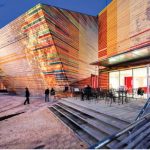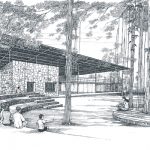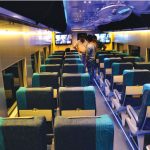-
Paolo Soleri – The Frugal City and Us
July 2013

ecocity.wordpress.com
Paolo Soleri, the visionary Italian-American architect and theorist who built the famed urban setting ‘Arcosanti’ in the Arizona high desert, died on the 9th of April 2013 at the age of 93. Soleri dedicated his life to promoting an art of living that re-establishes the all-important relationship between human beings and the environment they live in.
Milinda Pathiraja
Inescapably, Paolo Soleri will be most remembered as the planner, builder, promoter and philosopher of a radically new urban form based on the notions of ‘frugality’ and ‘arcology’.
The ‘Frugal City’, according to Soleri, is a complex urban settlement relying on ‘spatial closeness’ – or miniaturisation of urban form – to encourage convivial social life as well as to enable the rigorous utilization of natural and man-made resources. It is a call for ‘lean systems’ of urban living as opposed to ‘profligate systems’ and urban sprawl; spacing out human settlements, suburbia and sprawl nullify the urban effect whereas miniaturisation – or close togetherness in space – induces a complex, efficient use of resources through time-saving shortness of distance.
‘Arcology’, on the other hand, is a theory that Soleri developed by synthesising the principles of architecture and ecology. It is a theory of city planning that emphasizes efficiency in the use of space and materials, targeting the subsequent environmental purposes and social benefits. Loosely reminiscent of the works of Antonio Gaudi and Bruce Goff, and suggestive of the underlining ecological references, Soleri’s arcological designs have often mimicked the order that exists within a natural organism or an ecosystem. Like Gaudi and Goff, Soleri has also been subjected to polarized criticism; while some have dismissed his doctrines of city building as living in the past – or relics of hippie idealism – many others have hailed him as a realist and a pragmatic futurist.
Indeed, within the tradition of design utopias, Soleri’s arcological structures resemble the futurist visionary projections developed in the early decades of the 21st century, such as the Italian futurism of Antonio Sant’Elia and his school, the German expressionism of Bruno Taut or Enrich Mendelsohn, and the Russian constructivism of Jacob Tchernykov or the Vesnin brothers. His approach to urban planning can also draw references to Tony Garnier’s Cite Industrielle, Le Corbusier’s ville radieusse, Frank Lloyd Wright’s Broadacre City, Buckminster Fuller’s World Town Plan, and even G.A. Jellicoe’s Motopia.
However, what sets apart Soleri from other such urban visionaries is that his idea of city is evidently more than a program for building, but an ecological synthesis and metaphysical declaration to create a new order for human living. This burning desire to bring about a positive change in the future of mankind, had compelled Soleri to spend 30 years of his life building the experimental city Arcosanti, which is still under construction.
Launched in 1970, the Arcosanti Project contemplates a world where architecture and ecology are blended into one planned reality, and offers its visitors and inhabitants an opportunity to learn about environmentally-responsible architecture in a unique, hands-on workshop. Relying largely on the efforts of students and volunteer builders, 13 major structures have already been built on 25 acres in a 4,060-acre land preserve, which will eventually house a population of 5,000 residents. Designed for maximum accessibility and increased social interaction among the residents, the work at Arcosanti is also complemented by experiments on materiality, sustainable technologies and a ‘miniature’ logistical grid of resource sharing.
As Soleri claims, “we humans are ourselves logistical systems of enormous complexity, and once this logistical system is extended into a large space, it takes more and more resources to maintain it and keep it going at that scale – to fuel the cars, light the homes , water the crops, grow the food” (Soleri et. al., 2000). Arguing that the burden of maintaining this logistical grid may sooner or later exhaust the resources available, Soleri developed Arcosanti as a complex, miniature model of urban living that can be highly efficient in the processes of production and consumption. For example, Arcosanti is designed to rely, as much as possible, on the ‘soft technologies’ of sun and wind power and other renewable energy so as to reduce pollution and dependence on fossil fuels; material recycling, waste reduction, energy conservation, and the use of renewable energy sources each become part of a strategy for sustainability aimed at reducing the flow of resources and products through the habitat.
In theory at least Arcosanti – along with the notions of ‘frugality’ and ‘arcology’ – offers a response to many of today’s environmental and social problems that we are facing in our cities. On the one hand, it shows us a way of looking beyond the conventional capitalist model of material and design flows driven by market forces, and exposes us to new ideas of materialism and radical revision of how we conceive of matter and life. On the other hand, it offers us an alternative model of urban living, against the loss of quality of life through waste and opulence and the increasing problems of social alienation and exclusion. Given the emerging realities of continuous sprawl and urbanisation pressures in our cities, it is indeed high time for local architecture to embrace a new, materialist mode of practice based on social and ecological responsibility.











